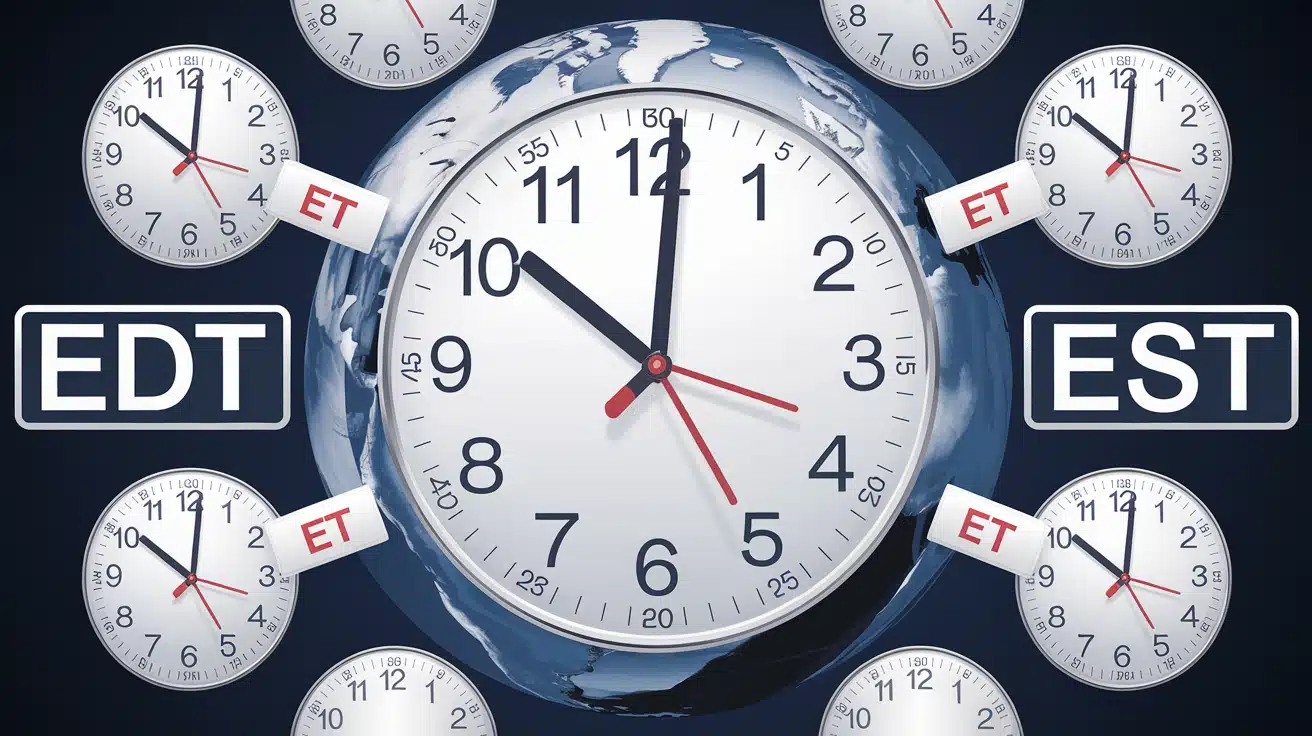EDT vs EST vs ET:Understanding Time Zones
Time zones can be confusing, especially when it comes to Eastern Daylight Time (EDT), Eastern Standard Time (EST), and the broad term Eastern Time (ET). These variations affect not just people in the U.S. but also international business dealings, travel, and communication. In this blog, we’ll demystify these terms, explain how they interact with Daylight Saving Time (DST), and offer practical advice on managing time zone complexities in daily life.
What is Eastern Daylight Time (EDT)?
Eastern Daylight Time (EDT) is a seasonal time zone observed during Daylight Saving Time (DST), typically in the spring and summer months. This time zone is used when clocks are shifted forward by one hour to make better use of daylight.
Key Details of EDT:
- Offset from Coordinated Universal Time (UTC): EDT is UTC -4 hours. For example, when it’s noon in UTC, it’s 8:00 AM in EDT.
- When It’s Used: EDT starts on the second Sunday of March and lasts until the first Sunday in November, covering most of the spring and summer months.
- Why It Matters: Shifting an hour ahead is meant to extend daylight hours into the evening, reducing the need for artificial lighting and potentially saving energy.
Fun Fact: The idea behind Daylight Saving Time originated from Benjamin Franklin, who suggested it as a way to conserve candles!
Business Impact of EDT
EDT plays a critical role in business meetings, especially for those scheduling calls across multiple time zones. Miscalculating the time difference during the Daylight Saving Time period can lead to missed meetings or confusion, especially when coordinating with international colleagues.
What is Eastern Standard Time (EST)?
Eastern Standard Time (EST) is the counterpart to EDT and is observed during autumn and winter when Daylight Saving Time is not in effect. It represents the “normal” time for the Eastern Time Zone.
Key Details of EST:
- Offset from UTC: EST is UTC -5 hours. When it’s noon UTC, it’s 7:00 AM in EST.
- When It’s Used: EST is observed from the first Sunday in November to the second Sunday in March.
- Seasonal Usage: EST is typically used in the colder months when daylight hours are shorter.
Example: Many parts of the United States switch from EDT to EST in the autumn, around November, as clocks are moved one hour back, signaling the end of Daylight Saving Time.
You can Also Read: Mastering the Verb “Run”: A Comprehensive Guide to Past Tense and Past Participle
Economic Factors Influencing Time Zones
The adoption of EST during colder months is often driven by practical and economic factors. Businesses, especially those reliant on daylight, prefer to align their schedules with natural light availability, minimizing the need for energy consumption during peak hours.
What is Eastern Time (ET)?
Eastern Time (ET) is a generic term used to refer to the time observed in the Eastern Time Zone, which includes both EDT (Eastern Daylight Time) and EST (Eastern Standard Time). The key to understanding ET is recognizing that it doesn’t specify whether Daylight Saving Time is in effect or not.
Why This Matters
When someone says a meeting is happening at “Eastern Time,” it’s crucial to clarify whether they mean EDT or EST, as this can affect the scheduling by one hour. This ambiguity can cause issues, particularly during the transition months of March and November when the clocks shift.
Key Differences Between EDT, EST, and ET
| Aspect | EDT (Eastern Daylight Time) | EST (Eastern Standard Time) | ET (Eastern Time) |
|---|---|---|---|
| UTC Offset | UTC -4 hours | UTC -5 hours | General (could be either) |
| When Observed | Spring and Summer (March – Nov) | Autumn and Winter (Nov – March) | Year-round term |
| Daylight Saving Time | Yes | No | Both |
| Common Confusion | Shifts 1 hour ahead | Standard time | Varies depending on season |
Time Zone Complexity in Communication
The complexity of time zones becomes clear during the transitions between EDT and EST. For example, scheduling a call with someone in North America during the autumn months can lead to confusion if you’re unsure whether they’re in EDT or EST. To avoid this, it’s best to confirm the exact time zone being used.
US States that Observe EDT, EST, and ET
Understanding which states observe EDT and EST is vital for clear communication, especially for business.
States Observing Eastern Daylight Time (EDT)
Some of the key US states that follow EDT during Daylight Saving Time include:
- New York
- Florida
- Virginia
- Georgia
These states observe EDT from March to November. During this time, they operate on UTC -4 hours.
States Observing Eastern Standard Time (EST)
During the winter months, these states switch back to Eastern Standard Time (EST):
- New York
- Ohio
- Maine
- South Carolina
In this period, they revert to UTC -5 hours.
Special Cases: The Caribbean and Other Regions
Some regions, such as the Turks and Caicos Islands, observe Daylight Saving Time and shift between EDT and EST. Additionally, many countries in the Caribbean observe Eastern Time year-round, often following either EDT or EST, depending on the time of year.
Daylight Saving Time and Eastern Time
Daylight Saving Time (DST) affects the Eastern Time zone by shifting clocks forward in the spring and back in the autumn. This adjustment impacts businesses and individuals alike, particularly those who rely on precise time-keeping systems.
How DST Affects EDT and EST
- Spring Forward: In March, clocks are moved forward by one hour, transitioning from EST to EDT. This shift gives longer daylight hours in the evening.
- Fall Back: In November, clocks are moved back an hour, shifting from EDT to EST.
This transition can impact everything from economic activity to time-keeping systems like computers and calendars.
Converting Eastern Time to Other US Time Zones
Understanding how to convert time zones is critical when working across different regions in the United States.
Converting EDT to Other US Time Zones
- Central Time (CT): Subtract 1 hour (e.g., 2:00 PM EDT = 1:00 PM CT)
- Mountain Time (MT): Subtract 2 hours (e.g., 2:00 PM EDT = 12:00 PM MT)
- Pacific Time (PT): Subtract 3 hours (e.g., 2:00 PM EDT = 11:00 AM PT)
Converting EST to Other US Time Zones
- Central Time (CT): Subtract 1 hour (e.g., 2:00 PM EST = 1:00 PM CT)
- Mountain Time (MT): Subtract 2 hours (e.g., 2:00 PM EST = 12:00 PM MT)
- Pacific Time (PT): Subtract 3 hours (e.g., 2:00 PM EST = 11:00 AM PT)
Dealing with the General ET Term
When someone says they’re operating on Eastern Time (ET), always ask if they mean EDT or EST. This clarification helps avoid errors, particularly during transitions between Daylight Saving Time.
Business Implications of Time Zone Confusion
The confusion between EDT, EST, and ET can have real-world impacts, especially in international business and scheduling calls.
Common Challenges
- Missed Meetings: A miscommunication between EDT and EST could result in missing crucial meetings.
- Economic Impact: Companies that deal with multiple time zones, such as airlines or tech companies, need to be meticulous about which time zone they’re referencing.
Tools for Managing Time Zones
To avoid confusion, consider using the following tools:
- World Time Buddy: A reliable tool for converting time zones accurately.
- Google Calendar: Automatically adjusts for Daylight Saving Time.
- Time Zone Converters: Online tools that help you manage different time zones effectively.
Conclusion: Mastering EDT, EST, and ET
Understanding the differences between EDT (Eastern Daylight Time), EST (Eastern Standard Time), and the broad term Eastern Time (ET) is essential for effective communication, especially when it comes to business meetings and scheduling across time zones. Whether you’re in the U.S. or collaborating internationally, being clear about which time zone you’re using is crucial for success.
By recognizing the seasonal changes brought by Daylight Saving Time and knowing how to convert times between regions, you can avoid confusion and keep your business running smoothly.
Stay on top of time zone changes to ensure you never miss a beat!







